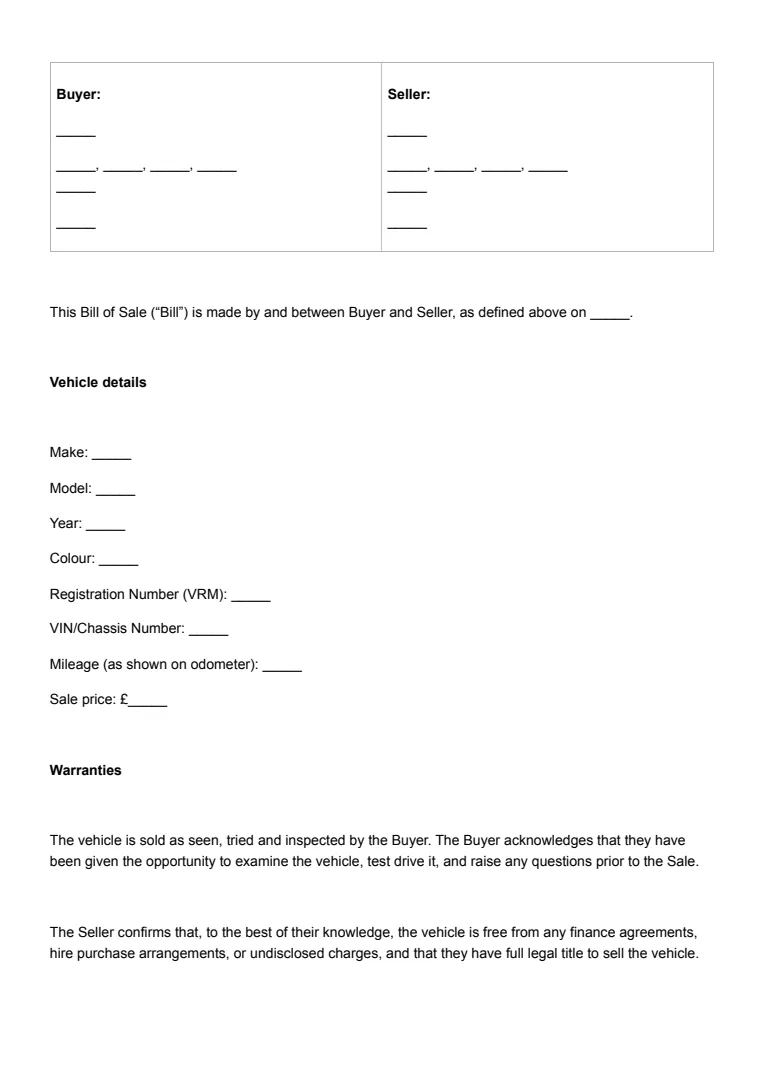What Is a Vehicle Bill of Sale?
A vehicle bill of sale is a document used when ownership of a car, motorcycle, or other vehicle changes hands. Whether it’s called a car bill of sale or a motor vehicle bill of sale, it’s basically proof that you sold or bought the vehicle.
If you’re buying privately, not through a dealership, you’ll often need to fill out a bill of sale for a car in the UK by hand or use a printed template. Dealers usually provide their own purchase contracts, which also serve as bills of sale.
You’ll typically need to include important vehicle details in a bill of sale for a vehicle, such as:
- Vehicle Identification Number (VIN)
- Make, model, and year
- Registration number
- Odometer reading
- Date of sale
- Names and addresses for you and the buyer/seller
Having a complete bill of sale helps you avoid disputes by confirming the transfer of ownership. It also provides proof of the sale price, which some local authorities may require for tax or registration purposes.
When writing or signing a vehicle bill of sale, ensure that all sections are completed clearly. Double-check the VIN, as errors in this number can cause delays when registering the vehicle. You can use a car bill of sale template UK or a sold as seen car template to guide you.
When Is a Vehicle Bill of Sale Needed?
You’ll need a vehicle bill of sale whenever you transfer ownership of a car to someone else. This could be through selling, trading, or even giving your vehicle away as a gift.
If you’re buying or selling a car privately, rather than through a dealership, a bill of sale is typically required. It’s also handy if you’re trading or exchanging your car with another person.
This document serves as your official record of the transaction. When you transfer a vehicle title, the Driver and Vehicle Licensing Agency (DVLA) recommends obtaining a bill of sale as proof of ownership.
A bill of sale is also needed when you’re gifting a vehicle.
How to Write a Vehicle Bill of Sale
A vehicle bill of sale is an essential document for the private sale of vehicles. Here’s a step-by-step guide to creating your own.
Step 1: Collect Key Vehicle Details
Start by collecting all the main details about the vehicle. You’ll need the make, model, year, Vehicle Identification Number (VIN), and the current odometer reading.
Step 2: Identify the Buyer and Seller
Clearly list the full names, addresses, and contact information for both you as the seller and the buyer.
This ensures transparency and makes identification easy.
Don’t forget to include the date of the sale, which is important for legal and registration purposes.
Step 3: Specify the Selling Price and Payment Method
State the agreed selling price and how payment will be made.
Under method of payment, include whether it’s cash, bank transfer, cheque, or another form. If a payment plan is involved, outline the terms in writing to avoid confusion.
Step 4: Include Signature and Notarisation Sections
Leave space for both the buyer and seller to sign the ‘bill of sale for car’.
Signatures can be witnessed by a notary public for additional security and evidence, who will also add their stamp and signature in a designated area.
Step 5: Use a Vehicle Bill of Sale Template UK to Ensure Accuracy
To make things easier, consider using a car bill of sale form or a template available online.
Step 6: Keep Copies and Attach Extra Documents
Make sure that both parties keep signed copies of the bill of sale for a car for their records.
Attach any extra documentation, such as the odometer disclosure statement, as part of the complete transaction packet.













